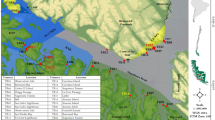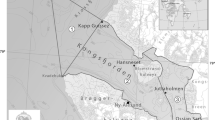Abstract
Photographs were taken every 0.5 m along three transects of 5.5 m length on shallow rock faces at Signy Island, Antarctica, during the austral summer of 1991/1992. The percentage cover of substratum ranged from 0 to 100% and the colonising communities included representatives of ten phyla. The zone from mean low-water neap level to 1.5 m depth was mostly devoid of organisms as a result of the seasonal formation of the encrusting ice foot. Coralline and macroalgae dominated from 2 to 3 m, and animal groups from 3.5 to 5.5 m. Bryozoans, and to a lesser extent sponges, were the most abundant animal phyla. Within the bryozoans a succession of colonisation of different species was observed, the most abundant two of which occupied >80% of substratum in places. Substratum type seemed to be the main factor influencing community development in the shallow sublittoral at Signy Island, although ice impact prevents community development in the top 1.5 m and limits it over the rest of the transect down to 5.5 m. Depth and profile of substratum also influenced communities within this depth range (particularly taxonomic composition).
Similar content being viewed by others
References
Arnaud PM (1992) The state of the art in Antarctic benthic research. In: Ferretti O, Gallardo VA, Moyano HI (eds) Actas del Seminario Internacional Oceanografia in Antartide, Centro EULA-Universidad de Concepcion, Chile, pp 341–436
Arntz WE, Brey T, Gallardo VA (1994) Antarctic zoobenthos. Oceanogr mar Biol A Rev (in press)
Ayling AM (1981) The role of biological disturbance in temperate subtidal encrusting communities. Ecology 62: 830–847
Barnes DKA (1994) Communities of epibiota on two species of erect antarctic Bryozoa. J mar biol Ass UK 47: 863–872
Barnes DKA (1995) Sublittoral epifaunal communities at Signy Island, Antarctica. II. Below the ice-foot zone. Mar Biol 121: 565–572
Barnes DKA, Clarke A (1974). Seasonal variation in the feeding activity of four species of antarctic Bryozoa in relation to environmental factors. J exp mar Biol Ecol 181: 117–133
Brey T, Clarke A (1993) Population dynamics of marine benthic invertebrates in antarctic and sub-antarctic environments: are there unique adaptations? Antarctic Sci 5: 253–266
Bullivant JS (1961) Photographs of antarctic bottom fauna. Polar Rec 10: 505–508
Bullivant JS (1967) Ecology of the Ross Sea benthos NZ J mar Freshwat Res 32: 49–75
Bullivant JS, Dearborn JH (1967) The fauna of the Ross Sea. Bull NZ Dep scient ind Res 176 1–76
Buss LW (1979) Habitat selection, directional growth and spatial refuges: why colonial animals have more hiding places. In: Larwood G, Rosen BR (eds) Biology and systematics of colonial organisms. Academic Press, London, pp 459–497
Clarke A (1990). Temperature and evolution. Southern Ocean cooling and the Antarctic marine fauna. In: Kerry KR, Hempel G (eds) Antarctic ecosystems — ecological change and conservation. Springer-Verlag, Berlin, pp 9–22
Clarke A, Crame JA (1989) The origin of the Southern Ocean marine fauna. In: Crame JA (ed) Origins and evolution of the Antarctic biota. Geological Society, London, pp 253–268 (Spec Publ)
Clarke A, Holmes LJ, White MG (1988) The annual cycle of temperature, chlorophyll and major nutrients at Signy Island, South Orkney Islands, 1969–82. Br Antarct Surv Bull 80: 65–86
Connell JH (1978) Diversity in tropical rain forests and coral reefs. Science, NY 199: 1302–1310
Dayton PK (1971) Competition, disturbance, and community organisation: the provision and subsequent utilisation of space in a rocky intertidal community. Ecol Monogr 41: 351–389
Dayton PK (1990) Polar benthos. In: Smith WO (ed), Polar oceanography. Part B: Chemistry, biology, and geology. Academic Press, London, pp 631–685
Dayton PK, Hessler RR (1972) Role of biological disturbance in maintaining diversity in the deep sea. Deep-Sea Res 19: 199–208
Dayton PK, Robilliard GA, Paine RT (1970) Benthic faunal zonation as a result of anchor ice at McMurdo Sound, Antarctica. In: Holgate MW (ed) Antarctic ecology. Vol. 1. Academic Press, London, pp 244–257
Dayton PK, Robilliard GA, Paine RT, Dayton LB (1974) Biological accommodation in the benthic community at McMurdo Sound, Antarctica. Ecol Monogr 44: 105–128
De Kluijver MJ (1993) Sublittoral hard-substratum communities off Orkney and St. Abbs (Scotland). J mar biol Ass UK 73: 733–754
Dell RK (1972) Antarctic benthos. Adv mar Biol 10: 1–216
Galéron J, Herman RL, Arnaud PM, Arntz WE, Hain S, Klages M (1992) Macrofaunal communities on the continental shelf and slope of the southeastern Weddell Sea, Antarctica. Polar Biol 3: 283–290
Gallardo VA, Castillo J (1969) Quantitative benthic survey of the infauna of Chile Bay (Greenwich I., South Shetland Is.). Gayana, Chile 16: 3–18
Gruzov EN (1977) Seasonal alterations in coastal communities in the Davis Sea. In: Llano GA (ed) Adaptations within antarctic ecosystems. Proceedings of the Third SCAR Symposium on Antarctic Biology. Smithsonian Press, Washington, pp 263–278
Hayward PJ (1991) Systematic studies on some antarctic and subantarctic Ascophora (Bryozoa, Cheilostomata). Zool J Linn Soc 101: 299–335
Hayward PJ (1992) Some antarctic and subantarctic species of Celleporidae (Bryozoa, Cheilostomata). J Zool, Lond 226: 283–310
Hayward PJ (1993) New species of cheilostomate Bryozoa from Antarctica and the subantarctic southwest Atlantic. J nat Hist 27: 1409–1430
Hayward PJ, Ryland JS (1990) Some antarctic and subantarctic species of Microporellidae (Bryozoa, Cheilostomata). J nat Hist 24: 1263–1287
Hayward PJ, Thorpe JP (1987) The systematic position of Smittina inclusa Waters, an endemic antarctic bryozoan. J nat Hist 21: 1469–1476
Hayward PJ, Thorpe JP (1988 a) Species of Chaperiopsis (Bryozoa, Cheilostomata) collected by ‘Discovery’ investigations. J nat Hist 21: 45–69
Hayward PJ, Thorpe JP (1988 b) A new family of cheilostome bryozoans endemic to the Antarctic. Zool J Linn Soc 93: 1–18
Hayward PJ, Thorpe JP (1988 c) Species of Arachnopusia (Bryozoa, Cheilostomata) collected by the ‘Discovery’ investigations. J nat Hist 22: 773–799
Hayward PJ, Thorpe JP (1988 d) New genera of antarctic cheilostome bryozoa. Cah Biol mar 29: 277–296
Hayward PJ, Thorpe JP (1989 a) Membraniporoidia Microporoidea and Cellarioidea (Bryozoa, Cheilostomata) collected by ‘Discovery’ expeditions. J nat Hist 23: 913–960
Hayward PJ, Thorpe JP (1989 b) Systematic notes on some antarctic Ascophora (Bryozoa Cheilostomata). Zoologica Scr 18: 365–374
Hayward PJ, Thorpe JP (1990) Some antarctic and subantarctic species of Smittinidae (Bryozoa, Cheilostomata). J Zool, Lond 222: 137–176
Hayward PJ, Winston JE (1994) New species of cheilostomate Bryozoa collected by the US Antarctic Research Program. J nat Hist 28: 237–246
Hedgpeth JW (1971) Perspectives of benthic ecology in Antarctica. Publs Am Ass Advmt Sci 93:93–136
Keough MJ (1984) Dynamics of the epifauna of the bivalve Pinna bicolor: interactions among recruitment, predation, and competition. Ecology 65: 677–688
Kirkwood JM, Burton HR (1988) Macrobenthic species assemblages in Ellis Fjord, Vestfold Hills, Antarctica. Mar Biol 97: 445–457
Kotlyakov VM, Smolvarova NA (1990) Elsevier's dictionary of glaciology. Elsevier, Amsterdam
Leakey RJG, Fenton N, Clarke A (1994) The annual cycle of planktonic ciliates in nearshore waters at Signy Island, Antarctica. J Plankton Res 16: 841–856
Logan A, MacKay AA, Noble JPA (1983) Sublittoral hard substrates. Can Spec Publ Fish aquat Sciences 64: 119–139
Logan A, Page FH, Thomas MHL (1984) Depth zonation of epibenthos on sublittoral hard substrates off Deer Island, Bay of Fundy, Canada. Estuar, cstl Shelf Sci 18: 571–592
Lubchenco J (1978) Plant species diversity in a marine intertidal community: importance of herbivore food preference and algal competitive abilities. Am Nat 112: 23–39
Magurran AE (1988) Ecological diversity and its measurement. Princeton University Press, Princeton
Meese RJ, Tomich PA (1992) Dots on the rocks: a comparison of percent cover estimation methods. J exp mar Biol Ecol 165: 59–73
Noble JPA, Logan A, Webb GR (1976) The recent Terebratulina communityin the rocky subtidal zone of the Bay of Fundy, Canada. Lethaia 9: 1–17
Nolan CP (1991) Size, shape and shell morphology in the antarctic limpet Nacella concinna at Signy Island, South Orkney Islands. J mollusc Stud 57: 225–238
Osman RW (1977) The establishment and development of a marine epifaunal community. Ecol Monogr 47: 37–63
Paine RT, Vadas RL (1969) The effects of grazing by sea urchins, Stronglylocentrotus spp., on benthic algal populations. Limnol Oceanogr 14: 710–719
Peck LS, Bullough LW (1993) Growth and population structure in the infaunal bivalve Yoldia eightsi in relation to iceberg activity at Signy Island, Antarctica. Mar Biol 117: 235–241
Rauschert M (1986) Zum Vorkommen von Priapulus tuberculatospinosus (Priapulida) in der marinen Fauna von King George, Süd-Shetland-Inseln. Antarktis. Mitt zool Mus Berl 62: 333–336
Rauschert M (1991) Ergebnisse der faunistischen Arbeiten im Benthal von King George Island (Südshetlandinseln, Antarktis). Ber Polarforsch (Bremerhaven). 76: 1–75
Richardson MD, Hedgpeth JW (1977) Antarctic soft-bottom, macrobenthic community adaptations to a cold stable, highly productive, glacially affected environment. In: Llano GA (ed) Adaptations within antarctic ecosystems. Proceedings of the Third SCAR Symposium on Antarctic Biology. Smithsonian Press, Washington, pp 181–196
Sanderson WG, Thorpe JP, Clarke A (1994) A preliminary study of feeding rates in the antarctic cheilostome bryozoan Himantozoum antarcticum. In: Hayward PJ, Ryland JS, Taylor PD (eds) Biology and palaeobiology of bryozoans. Olsen & Olsen. Fredensborg, pp 167–170
Sebens KP (1985) The ecology of the rocky intertidal. Am Scient 73: 548–557
Stebbing ARD (1973) Competition for space between the epiphytes of Fucus serratus L. J mar biol Ass UK 53: 247–261
Voß J (1988) Zoogeographie und Gemeinschaftsanalyse des Makrozoobenthos des Weddellmeeres (Antarktis). Ber Polarforsch (Bremerhaven) 45: 1–145
Walker AJM (1972) Introduction to the ecology of the antarctic limpet Patinegera polaris (Hombron & Jaquinot) at Signy Island, South Orkney Islands. Br Antarct Surv Bull 28: 49–71
Whitaker TM (1982) Primary production of phytoplankton off Signy Island, South Orkneys, the Antarctic. Proc R Soc (Ser B) 214: 169–189
White MG (1984) Marine benthos. In: Laws RM (ed) Antarctic ecology. Vol. 2. Academic Press, London, pp 421–461
White MG, Robins MW (1972) Biomass estimates from Borge Bay, Signy Island, South Orkney Islands. Br Antarct Surv Bull 31: 45–50
Winston JE (1983) Patterns of growth, reproduction and mortality in bryozoans from the Ross Sea, Antarctica. Bull mar Sci 33: 688–702
Winston JE, Heimberg BF (1988) The role of bryozoans in the benthic community at Low Island, Antarctica. Antarctic J US 21: 188–189
Zamorano JH (1983) Zonacion y biomasa de la macrofauna bentonica en Bahia South, Archiepéligo de Palmer, Antartica. Série Cient antarct chil Inst 30: 27–38
Author information
Authors and Affiliations
Additional information
Communicated by J. Mauchline, Oban
Rights and permissions
About this article
Cite this article
Barnes, D.K.A. Sublittoral epifaunal communities at Signy Island, Antarctica. I. The ice-foot zone. Marine Biology 121, 555–563 (1995). https://doi.org/10.1007/BF00349466
Received:
Accepted:
Issue Date:
DOI: https://doi.org/10.1007/BF00349466




